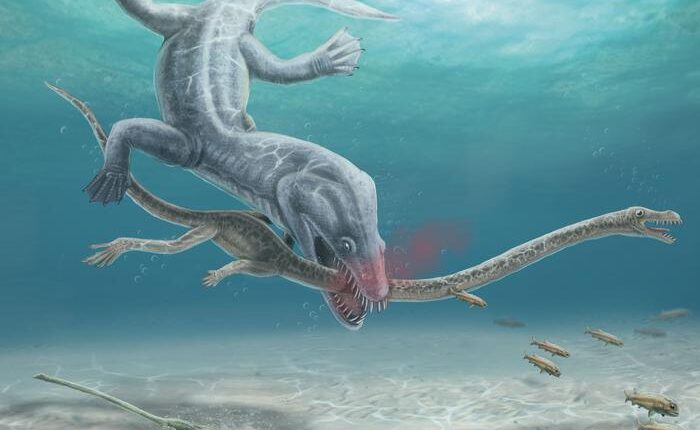A GINORMOUS beast that once dominated the sea was decapitated with a single nasty bite through its extremely long neck, experts have revealed.
The unusual creature had a neck up to three times the size of its torso.
While it was busy chomping through fish, other big sea monsters saw its long neck as a juicy weakness to exploit.
Scientists have finally confirmed the grisly death met by some of the Tanystropheus reptiles that lived 240million years old.
They had long-suspected this might be the case but have only just proven it after studying ancient fossils.
Researchers were stunned to find bite marks on two of the creatures’s necks.


“Paleontologists speculated that these long necks formed an obvious weak spot for predation, as was already vividly depicted almost 200 years ago in a famous painting by Henry de la Beche from 1830,” said Stephan Spiekman from Germany’s Stuttgart Museum.
“Nevertheless, there was no evidence of decapitation—or any other sort of attack targeting the neck—known from the abundant fossil record of long-necked marine reptiles until our present study on these two specimens of Tanystropheus.”
The Tanystropheus is a type of reptile distantly related to crocodiles, birds and dinosaurs.
Scientists have been curious about the species’s fate after only finding the end of their skinny neck and small head.
Most read in Tech
They now believe that those bits were probably discarded by hungry predators in favour of the meaty torso.
Eudald Mujal, also from Stuttgart Museum, told the Current Biology journal: “Something that caught our attention is that the skull and portion of the neck preserved are undisturbed, only showing some disarticulation due to the typical decay of a carcass in a quiet environment.
“Only the neck and head are preserved; there is no evidence whatsoever of the rest of the animals.
“The necks end abruptly, indicating they were completely severed by another animal during a particularly violent event, as the presence of tooth traces evinces.”
Find out more about science
Want to know more about the weird and wonderful world of science? From the Moon to the human body, we have you covered…
We pay for your stories! Do you have a story for The Sun Online Tech & Science team? Email us at [email protected]
This post first appeared on Thesun.co.uk










